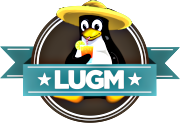![]()
J’ai eu le problème de la fenêtre blanche avec skype… horreur impossible de voir la famille par cette magnifique fenêtre sur le monde qu’est internet. Merci la 3D !
(more…)
-
With screen with compiz
-
Our July meeting
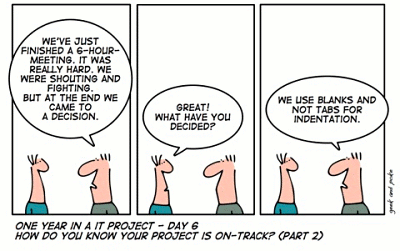
The next LUGM meeting will take place at the usual venue on 4 July 2009 at 10:00. A tentative agenda is:
- Status of registration of the association
- Status of the development and deployment of the new website
- Involvement in the Fedora Electronic Lab distribution (made by a Mauritian, Chitlesh Goorah!)
- AOB
The meeting will be followed by a technical presentation (the exact topic will be confirmed in a few days) and we’ll have lunch together afterwards.
Everyone is invited!
-
Hier j’ai compilé mon OS
Les distributions pourraient se disposer sur les rayons des supermarchés tellement elles sont nombreuses. On en trouve pour tous les gouts et toutes les couleurs.
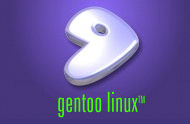
Gentoo Distrib
D’une classique Ubuntu, installable les yeux fermés à une LFS qui nécessite de faire un peu d’assembleur avant de démarrer. Pour ma part je pense que Gentoo propose une bonne alternative pour les Geeks en mal de pouvoir de compilation avec des ordinateurs toujours plus puissants.
Mais pourquoi se priver du plaisir de la compilation !
(more…) -
Back to the future

I’m happy!
After years and years of inactivity (let’s be honest!), the LUGM website is alive again! As you can see, this is a blog and I expect you to make it become alive with a lot of insightful and passionate comments. Of course, we’ll also participate in the discussions.
As you all know, the Linux User Group of Mauritius has a number of objectives namely (i) advocate (ii) support (iii) educate and (iv) make people meet. During the coming months, we will make a number of important announcements concerning events that we intend to organise… with your help! Stay tuned.
The past
When LUGM started 10 years ago, Linux was still a curiosity… especially here in Mauritius.
As a matter of fact, I got into Linux myself par hasard. I had a Windows NT server around 1999 and it was tough to configure (in fact, a lot of things were not working properly.) I stumbled upon a copy of the PC Quest magazine with Redhat Linux 6.2 as cover disk. Little by little, I migrated all the services from the NT box to a Pentium 133 with 32 Mb running the Redhat Linux 6.2 and everything worked great. I then decided that life was too short to care about NT and became a Linux addict.
Of course, things were not always rosy. I fondly remember having to fight with the X-Window configuration files on a daily basis. And a lot of services could only be configured after read documentation and HOWTOs thoroughly. But, at least, they worked as expected…
But Linux was fun! I really enjoyed learning about the UNIX way of doing things. It is then that I decided to share my passion with others, first by announcing the launching of this Linux User Group then by introducing my students to Linux. I remember deploying Linux to the Mauritius Chamber of Commerce and Industry and the University of Mauritius to great effect. Many of the students loved Linux as it allowed them to explore areas of Computer Science that they were not really aware of.
On the commercial front, we did a survey on the use of Linux in Mauritian companies in 2003 and the results are still interesting to read.
Now
Linux is now a common occurrence in Mauritian companies. And this is true for a lot of open source software too. Of course, most of the desktop computers still run Windows (and I expect this to continue for some years until everyone becomes mobile) but a lot of the largest servers in the country are powered by Linux.
Interestingly, a lot of devices being used by Mauritians all day long (e.g. the Mauritius Telecom Livebox and the Sony Bravia LCD TVs) run Linux.
As far as I know, the rate of adoption of open source software is increasing (simply because, for most of them, they work great!)
There is one thing which I don’t like though, the Mauritian Linux community is still largely fragmented and I hope that this new website will enable us all to work together (and also have a lot of fun together.)
The future
It all depends on you. What do you want us to do?
-
Survey on the use of Linux in Mauritius
Who are we ?
The Linux User Group of Mauritius (LUGM) exists since November 2000 and our main roles are:
- Advocate
- Educate
- Support
- Socialise
- Coordinate Linux and OSS activities in Mauritius
Web site and mailing list
- http://www.lugm.org
- http://www.lugm.org/mailing-list/
Scope of the survey
What we were looking for
- Patterns of use of Linux and OSS in Mauritius
- Meaning of Open Source
- Knowledge of our existence
Methodology
- Sample of 80-100 IT managers
- Questionnaire based
- Anonymous
The results: Heard about Linux ?
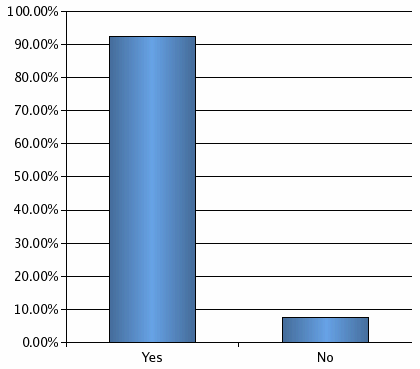
A vast majority of IT managers has heard of Linux (92.5%)
The rest (7.5%) must be living on another planet 🙂
How did you discover it ?
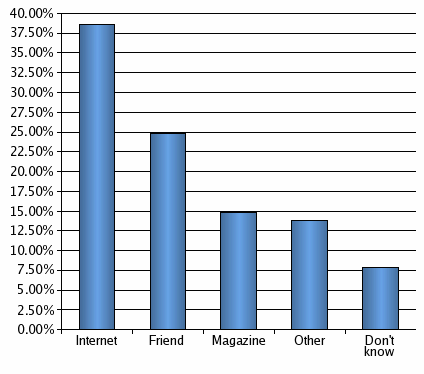
Multiple answered we allowed.
We see the ever increasing role of the Internet as a means fo propagate knowledge.
Where do you use Linux ?
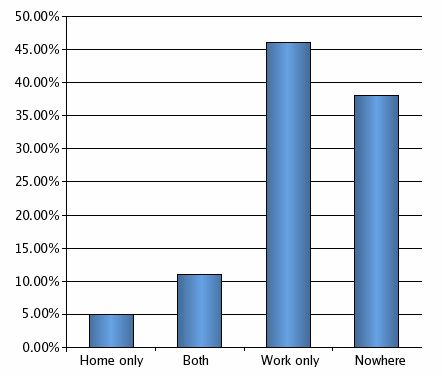
38% of the IT managers questioned do not use Linux, neither at work nor at home.
Of those 62% left, the majority use Linux only at work
This seems to indicate that Linux is being used as a server operating system.
Distribution used ?
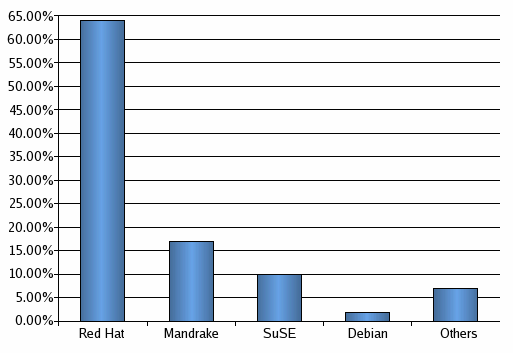
Pattern of use of distributions in Mauritius is exactly the same as worldwide.
Red Hat rules !
Applications used ?
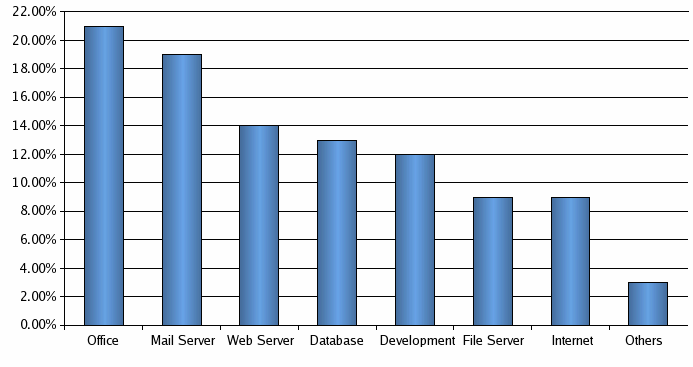
Surprisingly, the type of application mostly used is Office applications (presumably Star Office and Open Office).
On the other hand, server applications (Mail, Web, Database and File Servers) amount to 55% which is coherent with the deduction made previously.
What about paid support ?

A majority thinks that Linux support should not be commercial.
This is very surprising given that most of those questioned use Linux at work.
An interpretation is that they are satisfied with the level of support they get in forums and websites.
Deployment date ?
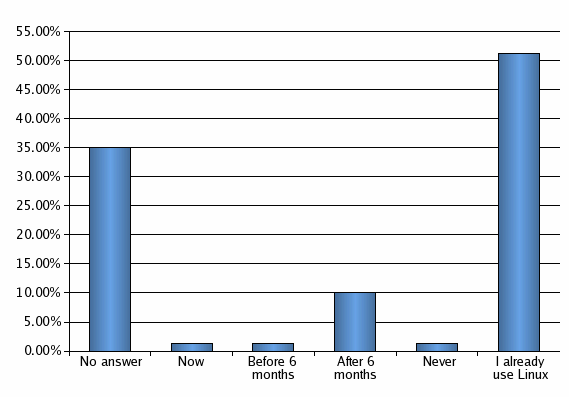
The majority of those questioned already have deployed Linux-based solutions at work. This is absolutely fantastic 🙂
Unfortunately, 35% do not know whether they’ll do it or not.
They are the ones we need to convince.
What is Open Source ?
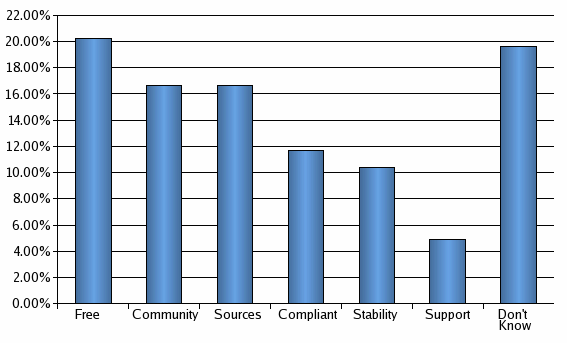
One out of five IT managers does not know anything about Open Source…
Any Contribution ?
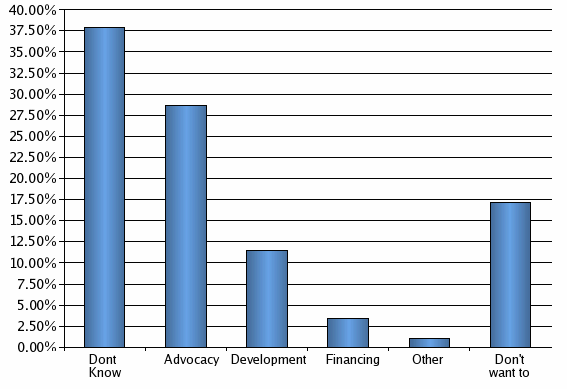
Frightening !
38% do not know how to help.
And about 20% do not want to help.
Linux and Open Source is all about give and take !!!
Heard about LUGM ?
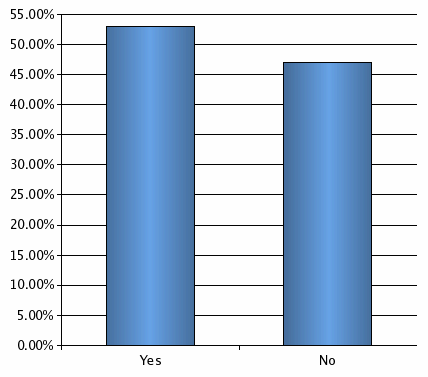
55% of Mauritian IT managers know that LUGM exists.
Satisfied with LUGM ?
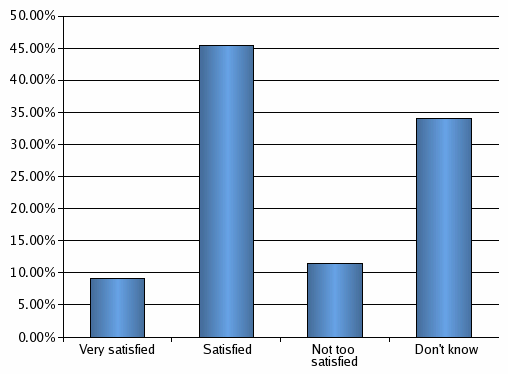
About half of those who know LUGM are satisfied with it.
It is important that those who are unsatisfied with LUGM’s actions come forward and make proposals.
That’s the whole point of having a community…
Conclusions ?
A majority of Mauritian IT Managers
- know Linux and Open Source software
- have deployed Linux and OSS-based solutions
- do not require commercial support
- do not contribute to the OSS movement.
They could help
- Technically <=> participate in OSS development
- Financially <=> reward deserving developers & projects
- Logistically <=> help in a LUG (for example LUGM :-))
Copyright Avinash Meetoo | Published under the Gnu Free Document License
-
10 reasons why Linux is better than Windows for the Mauritian School IT Project

1) Linux is free !
Linux distributions can be obtained freely and copied at will.
2) Linux is open source !
The sources of Linux and thousands of other open source applications are readily available. Learning to build software becomes easy just by looking at those examples.
3) Linux has a community of users !
Linux is not only an operating system but also an extensive community of users willing to share experiences and support each other. The Linux User Group of Mauritius (www.linux.mu), among others, represents this community in Mauritius. Extensive user documentation created by fellow Linux users exists on the Internet (www.tldp.org).
4) Linux runs thousands of software !
A Linux distribution typically contains loads of software (e.g. Redhat Linux 9 comes with 1402 software packages) and many more can be obtained on the Internet (e.g. on www.freshmeat.net and www.sourceforge.net). Most of these software packages (e.g. productivity, graphical, educational, software development or Internet applications) are free.
5) Linux is robust, secure and efficient !
Linux has been designed to be very robust (it recovers gracefully from the whole range of exceptional situations), secure (every user can have private files and specific privileges) and efficient (it can be used on previous generation computers like 486s and Pentium I). Some very well-known companies now use Linux for their processing needs (e.g. Amazon, Google, the NASA, the CIA and even our own Mauritian Servihoo).
6) Linux is based upon open standards and open protocols !
Linux implements most open standards and open protocols including but not limited to TCP/IP, HTTP, MathML, PNG, SOAP, Web Services, XHTML, XML, XSL…
7) Linux is compatible with everything else !
Linux can easily coexist and work with all kinds of alternative operating systems systems (like Unix, Windows, MacOS…). Linux applications can also read and write files in proprietary format (like .doc or PDF). Linux can even run some Windows applications (most notably office applications).
8) Linux is an excellent environment to learn programming !
A Linux distribution comes with numerous software development environment and compilers (for C, C++, Java, Python, TCL/Tk, Fortran, Ruby…).
Java 2 Enterprise Edition is also available through the freely available J2EE implementations from Sun or JBoss. With the availability of the two leading open source databases in most distributions, PostgreSQL and MySQL, a student has all the tools required to learn to build extensive enterprise software applications.
9) Linux can be easily administered remotely !
Every computer running Linux can be administered remotely using the very secure SSH protocol. This means that all eventual maintenance and installations can be done remotely. This implies that every school need not have a local system administrator.
10) Linux is being promoted by some very well-known companies !
IBM (www.ibm.com/linux), HP (www.hp.com/linux), Oracle (www.oracle.com/linux), SAP (www.sap.com/linux), Sun (www.sun.com/linux) and other well-known companies are heavily investing and developing products for Linux.
This clearly shows their trust in Linux.
Linux is the future !
Thanks to all those who have contributed ideas and to Yash Nursinghdass in particular.
Copyright Avinash Meetoo | Published under the Gnu Free Document License
-
GNU, Linux, Logiciels Libres et Open Source
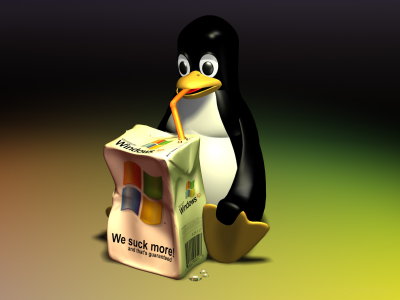
Introduction
Ce texte vise à introduire l’historique de GNU/Linux et des Logiciels Libres et ’Open Source’ ainsi que leurs avantages de façon succinte. Strictement parlant, il serait plus correct de commencer chronologiquement par GNU et Richard Stallman. Cependant, j’ai préféré mentionner le plus familier avant d’aborder les parties moins connues afin de permettre au lecteur de mieux faire les connexions de lui-même.
Linus Torvalds et Linux
Linux est aujourd’hui un système d’exploitation compatible avec les normes Posix (et on peut dire compatible avec les systèmes et logiciels UNIX) très sécurisé, très rapide et très robuste, et en plus gratuit, dont le code source est disponible.
Linux fut d’abord un noyau de système d’exploitation, conçu et développé à l’origine uniquement par un jeune étudiant Finlandais, Linus Torvalds. En 1991, âgé de 26 ans, en deuxième année d’études en Sciences Informatiques à l’Université de Helsinki, Linus Torvalds débuta le développement sur une machine abordable avec un processeur Intel 386, mais ensuite, décida aussi de mettre le noyau ainsi que son code source à disposition d’autres personnes gratuitement, en les rendant accessible via Internet.
Les points qui motivèrent Torvalds à développer Linux furent :
- Les énormes coûts associés aux matériels et logiciels nécessaires pour faire tourner un environnement UNIX
- Les faibles capacités et la faible réactivité par rapport aux demandes d’améliorations des utilisateurs du système d’exploitation MINIX d’Andrew Tannenbaum, un professeur d’Université, utilisé surtout dans l’univers académique
- Les grands délais associés au développement du système d’exploitation du projet GNU lancé presque neuf ans auparavant par Richard Stallman.
La disponibilité du code source au public fit qu’un nombre grandissant de personnes détectèrent des améliorations possibles et aussi envoyèrent leurs propres ajouts au code de Linus. Ainsi, le système Linux a toujours été continuellement amélioré depuis, grâce au travail de très nombreux collaborateurs de diverses parties du monde. Les collaborateurs travaillent de façon volontaires, et très souvent durant leur temps libre.
Plus de dix ans plus tard, de nos jours, Linux est un système qui est grandement utilisé dans tous les domaines ou sont nécessaires une fiabilité, une sécurité, une robustesse, une rapidité accrues, ainsi qu’une approche économiques avec en plus la possiblité d’adapter le code source.
Linux se retrouve ainsi dans les Compagnies commerciales, les Gouvernements, les secteurs de l’Education et de l’Enseignement avancé, la Recherche, etc…
De nombreuses compagnies commerciales ont migré leurs opérations et leurs logiciels vers Linux pour des raisons de fiabilité, de rapidité, de sécurité, de robustesse et d’impact économique positif. En effet, de nombreuses séquences à effets spéciaux dans les films récents sont produits sur des logiciels tournant sous Linux. IBM est un grand supporter de ce système d’exploitation. Oracle, PeopleSoft et SAP ont tous commencé la migration de leurs produits sous Linux.
Liens:
- Why Linux is Great
- The Greatest OS that (N)Ever Was (Wired Magazine)
- Linux.org
- Open Sources: Voices from the Open Source Revolution
- Tribune Libre: Ténors de l’Informatique Libre
Richard Stallman, GNU et la FSF
Une licence particulière décrit ainsi l’utilisation du code source de Linux. C’est la licence GPL : la GNU Public Licence, qui stipule, entre autres, que quiconque modifie le code source mis à disposition a le devoir de réinjecter le nouveau code source dans la communauté des utilisateurs.
GNU est un projet préexistant à Linux, de Richard Stallman, un étudiant de Harvard qui a travaillé pendant longtemps aboratoire d’intelligence artificielle de MIT, le AI Lab. Dans l’environnement de AI Lab, il existait déjà une culture de partage de codes sources afin que tous les employés puissent apporter leur améliorations afin que la communauté internet au AI Lab en bénéficie. Ainsi, de nombreux problèmes avec les machines et les logiciels de l’époque furent réglés par ces collaborations et ces ententes tacites en plus de l’approche de partage de codes sources.
En 1983-1984, Richard Stallman fit de cette façon de procéder un projet, qui deviendra son projet de vie, son chef d’oeuvre en quelque sorte. L’idée de GNU est de produire et de promouvoir une combinaison de Système d’Exploitation et de Logiciels Libres compatibles UNIX, gratuitement si possible ou pour des sommes modiques à tous ceux qui en ont besoin.
Dans la sphère GNU, la notion de ’liberté’ dans ’Logiciel Libre’ décrit les caractéristiques suivantes pour l’utilisateur qui peut donc :
- l’utiliser librement,
- le donner à quelqu’un d’autre librement,
- le modifier librement,
- le vendre si on veut,
- en utiliser une partie dans un autre travail, même non libre.
Richard Stallman fonda par la suite, la Free Software Foundation, FSF, spécifiquement pour promouvoir les notions de liberté liées aux logiciels.
De par son effort personnel initialement, et ensuite de par la contribution de centaines d’autres personnes de par le monde, le projet GNU se voit depuis son lancement, grandir en termes de logiciels libres disponibles. Par exemple, GNU Emacs, l’éditeur personnalisable, et GCC, l’ensemble de compilateurs GNU, sont des produits de Stallman à qui d’autres ont contribués.
Cependant, le Système d’Exploitation prévu par Richard Stallman, le GNU Hurd, fut très longtemps en développement ce qui rendait une bonne partie de son projet incomplet. En effet, bien que les logiciels GNU devenaient plus nombreux et disponibles, il fallait encore utiliser les coûteux environnements UNIX pour les utiliser alors que Stallman voulait démocratiser l’accès au couple Système d’Exploitation et Logiciels.
Liens:
GNU/Linux, collaboration via Internet et autres synergies
C’est donc grâce au mariage des concepts et des application GNU au système d’exploitation Linux, que purent se concrétiser les rêves de Richard Stallman. Ce dernier d’ailleurs insiste toujours à raison que ce que l’on appelle communément une distribution Linux devrait en fait être plus correctement nommé GNU/Linux.
Une distribution Linux est donc en fait une collection de Logiciels GNU avec le Système d’Exploitation Linux, généralement regroupés et distribués gratuitement (FTP, CDROMS) ou commercialement (généralament en boîte avec CDROMS) par des équipes voire des compagnies, comme Red Hat, SuSe, Mandrake, etc…
L’avènement de Linux a aussi fortement bénéficié des possibilités de collaboration à distance offertes par le noyau Internet Pré-Web de la période 1983-1995 (e.g. les listes de diffusion, Usenet, etc…), mais ensuite aussi des possibilités de collaborations grâce au Web, tels que SourceForge et d’autres environnements tels les forums de discussions.
Eric Raymond et les Logiciels ’Open Source’
Eric Raymond est un de ces contributeurs au projet GNU. En l’occurrence, il a développé le logiciel SendMail. De plus, il est un fin observateur des processus de collaboration et de développement qui sont particuliers au domaine GNU/Linux et Logiciels Libres.
Plus précisément, dans ses textes, dont “The Cathedral and the Bazaar”, il décrit comment d’après-lui, l’approche partage de code source et collaboration ouverte a permis le développement de l’ensemble complexe GNU/Linux, alors que beaucoup de compagnies commerciales, ont des équipes entières de développeurs qui se cassent les dents sur la complexité grandissante des logiciels.
En d’autres mots, Eric Raymond pense que ce qui explique la plus grande fiabilité, sécurité et robustesse des logiciels développés avec cette approche collaborative particulière, c’est bien l’aspect développement ouvert avec code source disponible. Ceci s’explique en partie pour lui, par le fait que vu le nombre de collaborateurs grandissant, pour au moins une personne dans le monde, tel ou tel bug, sera une chose triviale à régler. Et dans le développement de logiciels, même si les temps de développements peuvent être estimés, la découverte de bugs et leur élimination sont souvent des inconnues.
Et en vérité, il existe des exemples où certains bugs liés à la sécurité furent éliminés en une période d’une journée grâce à un ou plusieurs collaborateurs via Internet. Cette grande réactivité est à comparer avec une compagnie commerciale, qui d’abord nie l’existence du bug, pour ensuite prendre deux semaines ou plus pour de régler le problème. Pendant ce temps, l’utilisateur du système se retrouve avec un environnement vulnérable.
Lorsqu’en 1998, Netscape annonce la mise à disposition du code source de son browser Web, cela est interprété par Raymond comme le premier exemple provenant d’une compagnie commerciale, de l’acceptation de la supériorité du modèle ’Logiciel Libre’ et partage de code source si prisé par Stallman, Torvalds et les nombreux collaborateurs des environnements GNU/Linux.
De plus, il réalise alors qu’il est peut-être nécessaire de mieux moduler et exprimer les concepts car il apparaît alors que le futur sera fait de plus étroites collaborations entre les compagnies commerciales et les collaborateurs souvent altruistes et non-commerciaux des projets GNU/Linux. C’est ainsi qu’il décide d’adopter les termes ’Open Source’ plutôt que ’Free Software’ que propose toujours Richard Stallman. Mis à part certains détails fins, dans l’ensemble ces deux termes peuvent être interchangés sans problèmes dans de nombreux cas. Cependant, il semble que les termes ’Open Source Software’ sont plus courants que ’Free Software’ de nos jours.
C’est ainsi que Eric Raymond formalisera ’The Open Source Initiative”, un organisme qui décrit les avantages des logiciels à code source ouvert.
Liens:
GNU/Linux à Maurice
GNU/Linux est présent à Maurice dans divers secteurs. Cependant il est probable que GNU/Linux bénéficie d’une faible visibilité. C’est dans l’optique de mieux faire connaître cet sphère, le Système d’Exploitation Linux, les Logiciels GNU, les Logiciels Libres et ’Open Source’ qu’est écrit ce texte.
Les enjeux et les avantages pour divers secteurs du pays, voire pour les projets specifiques et stratégiques du pays sont nombreux. Prenons l’exemple du projet CyberCité : tous les produits GNU/Linux sont fortement basés sur des Standards et des protocoles standards qui sont le coeur même de la communication Internet. Mieux encore, des études ont démontré que certaines des implantations des protocoles standards dans les produits GNU/Linux sont les meilleurs au monde (e.g. la pile TCP).
Cela veut dire que l’adoption de GNU/Linux prépare d’autant mieux le pays à s’intégrer dans la nouvelle économie à l’échelle mondiale dont une très grande composante est le commerce électronique via Internet, avec un investissement économique optimisé. Ceci, d’autant plus que certaines compagnies commerciales sont connues pour leurs pratiques monopolistiques, visant à continuellement augmenter le prix de leurs logiciels, ou enfermer les utilisateurs dans soit des licences qui les exploitent soit dans des protocoles non-standards.
Il est d’autant plus important de faire une bonne évaluation en ce qui concerne les projets spécifiques et stratégiques gouvernementaux car les coûts seront souvent répercutés sur les contribuables. Les gouvernements de nombreux pays étrangers ont décidé de soit évaluer de près les alternatives GNU/Linux ou de les adopter dans leurs projets. On peut notamment citer le Pérou, la France, l’Allemagne, les USA, la Chine, l’Afrique du Sud, l’Angleterre, et de nombreux autres pays.
Si vous êtes dans le Gouvernement, le Secteur Privé, le secteur de l’Education ou utilisateur individuel, pour avoir plus de renseignements concernant GNU/Linux, les Logiciels Libres et ’Open Source’, il est fortement recommandé de visiter régulièrement le site du M.L.U.G. (voir ci-dessous).
Le paysage local de GNU/Linux est composé en autres de :
- Le Linux User Group of Mauritiu au travers duquel ce texte a vu le jour. Pour plus de renseignements sur GNU/Linux et les Logiciels Libre et ’Open Source’, il est fortement recommandé de visiter le site régulièrement voire de s’inscrire à la liste de diffusion.
- Linux User Group de l’Université de Maurice
- IBL, qui représente la compagnie commerciale Red Hat qui vend une distribution GNU/Linux réputée, et partenaire d’IBM qui est un grand promoteur et vendeur de produits Linux.
- TuxCafe, qui est une cybercafé entièrement constitué de machines tournant sous GNU/Linux.
Liens :
- A Timeline of Open Source in Government
- Use of Free Software in Government agencies in Peru
- Linux in Government
- The Halloween Documents
- What’s so bad about Microsoft ?
- What alternatives are there to Microsoft ?
Copyright Yash Nursinghdass | Published under the Gnu Free Document License
-
Open source versus proprietary software

Abstract
The purpose of this article is to make an unbiased and objective comparison of open source and proprietary software. For the sake of argument, the Linux operating system will be taken as an example of open source software while the Windows operating system will be an example of proprietary software. Both short-term and long-term issues will be examined with a view of providing enough data for someone to be able to make an informed decision between these two software families.
Introduction
The terms of use of either an open source software (OSS) or a proprietary software (PS) are clearly stated by its license. The exact definition of an open source license (OSL) can be found on the Open Source Initiative website. It should be noted that most open source softwares are under the GNU Public License including the Linux operating system.
On the other hand, there is not an exact definition of proprietary license (PL). My personal stance is to consider that if a license is not open source then it is proprietary. More concretely, if the license associated with a software is not in conformity with at least ONE of the terms defined by the Open Source Initiative, then the license is proprietary. The Microsoft Windows 98 Second Edition End-User License Agreement will be taken as an example of a proprietary license.
Methodology of the comparison
Being readily available, the comparison will be based on each term of the Open Source Initiative’s definition of an Open Source license. An interpretation will be made regarding Linux. This will be followed by investigating whether an equivalent term exist in the Microsoft End-User License Agreement.
The comparison: Redistribution
“The license shall not restrict any party from selling or giving away the software as a component of an aggregate software distribution containing programs from several different sources. The license shall not require a royalty or other fee for such sale.” [OSI] In other words, an OSS can be given for free. For example, installing Linux on several hundred computers does not cost anything. On the other hand, installing Windows requires the payment of a fee for each and every installation. It can be argued that Microsoft can also decide to give copies of Windows freely. But, in the long run, when upgrading Windows to a newer version (which comes out about every two years), fees will have to be paid given that Microsoft is a commercial entity whose main objective is to make profits by selling Windows and other proprietary software.
The comparison: Source Code
“The program must include source code, and must allow distribution in source code as well as compiled form. Where some form of a product is not distributed with source code, there must be a well-publicized means of obtaining the source code for no more than a reasonable reproduction cost – preferably, downloading via the Internet without charge. The source code must be the preferred form in which a programmer would modify the program. Deliberately obfuscated source code is not allowed. Intermediate forms such as the output of a preprocessor or translator are not allowed.” [OSI] The source of a program describes its inner working, allows one to be sure that no hidden (and potentially dangerous) feature exists, lets other programmers (or students) learn by example and, most important, allows one to correct and modify the software. This “opening” of the software is the most distinguishing feature of OSS. For instance, the Linux operating system is about 4,700,000 lines of industrial quality C code. Someone learning to build an operating system or enhancing one only has to look at those lines of code. In the same way, a paranoiac system administrator can read the code and convince herself that Linux is not harmful in any way. This is the ultimate empowerment of the final user.
On the other hand, Windows is distributed without its source code and, therefore, it is absolutely impossible to learn how it is done, audit it for maximum security, correct errors or improve it. It is impossible for our paranoiac system administrator to be 100% sure that she is not introducing a major vulnerability in her network when installing a new version of Windows. It is also absolutely impossible for a motivated student to learn how Windows is internally built.
A very important consequence is that whenever a defect is detected in Windows, it is only Microsoft (the sole owner of the source code) who can correct it. And if Microsoft decides that the error is not worth correcting, it will remain in all subsequent versions of Windows.
The comparison: Derived Works and Integrity of The Author’s Source Code
“The license must allow modifications and derived works, and must allow them to be distributed under the same terms as the license of the original software.” [OSI]
“The license may restrict source-code from being distributed in modified form only if the license allows the distribution of “patch files” with the source code for the purpose of modifying the program at build time. The license must explicitly permit distribution of software built from modified source code. The license may require derived works to carry a different name or version number from the original software.” [OSI] This is a direct consequence of the fact that the source code of an OSS can readily be obtained. All modifications, either correction or additions, must always remain open source. That is, someone is not permitted to take Linux, change it in some minute way and sell it under a proprietary license. Obviously, this is what has permitted the open source community to prosper. “Secondly, an open source license must guarantee that source be readily available, but may require that it be distributed as pristine base sources plus patches. In this way, “unofficial” changes can be made available but readily distinguished from the base source.” [OSI]. In other words, there must be a way to distinguish between the original work and the derived work (so that the final user has the possibility to choose which one to use).
Windows, being distributed without its source code, does not, obviously, allow for derived works.
The comparison: No Discrimination Against Persons or Groups
“The license must not discriminate against any person or group of persons.” [OSI] An open source software can be used by any person irrespective of nationality, ethnic group, economic group or religious group. This might seem natural but one only has to look at the Microsoft End-User License Agreement to find that Windows cannot be used by certain groups of people :
“You agree that you will not export or re-export the software product to any country, person, or entity subject to U.S. export restrictions. You specifically agree not to export or re-export the software product :
(i) to any country to which the U.S. has embargoed or restricted the export of goods or services, which as of March 1999 include, but are not necessarily limited to Cuba, Iran, Iraq, Libya, North Korea, Sudan and Syria, or to any national of any such country, wherever located, who intends to transmit or transport the software product back to such country ;” [MIC] What is surprising is that the distributor of Windows is the one responsible for enforcing U.S. export restrictions. One question arises : what happens if a country decides to choose Windows and then afterward gets on the black list of the U.S.A. ?
The comparison: No Discrimination Against Fields of Endeavor
“The license must not restrict anyone from making use of the program in a specific field of endeavor. For example, it may not restrict the program from being used in a business, or from being used for genetic research.” [OSI] An open source software can be used by someone working in any field whatsoever. On the other hand, Windows cannot be used in the following fields of endeavour :
“You agree that you will not export or re-export the software product to any country, person, or entity subject to U.S. export restrictions. You specifically agree not to export or re-export the software product :
[…]
(ii) to any person or entity who you know or have reason to know will utilize the software product or portion thereof in the design, development or production of nuclear, chemical or biological weapons ;” [MIC] This seems to be sensible until one considers that doing research in the fields of nuclear, chemical or biological weapons is what many top U.S. scientists have been doing for decades… One, therefore, cannot see the rationale behind such arguments.
The comparison: Distribution of License
“The rights attached to the program must apply to all to whom the program is redistributed without the need for execution of an additional license by those parties.” [OSI] This implies that every redistribution of an open source software must remain open source. “This clause is intended to forbid closing up software by indirect means such as requiring a non-disclosure agreement.” [OSI] On the other hand, Windows is distributed with a “closed” license which, basically, give you the right to have no rights…
The comparison: Additional requirements
There exist some additional requirements for a license to be open source :
The license must not be specific to a product. That is, the rights attached to the software must not depend on the program’s being part of a particular software distribution. [OSI] The license must not restrict other software. This implies that an open source software can be distributed with other types of softwares (be them open source or not). OSI 02 The license must be technology-neutral. This indicates that the software be available through all classical modes of distribution (CD, HTTP, FTP…) [OSI]
Conclusion
Both open source and proprietary software exist. And they mostly work as expected. But, freedom of use, of redistribution and of modification really exists only in the case of open source software.
For this reason, my recommendation is to always choose an open source version of a software over a proprietary and closed alternative.
My recommendation is therefore to choose Linux over Windows.
Copyright Avinash Meetoo | Published under the Gnu Free Document License
